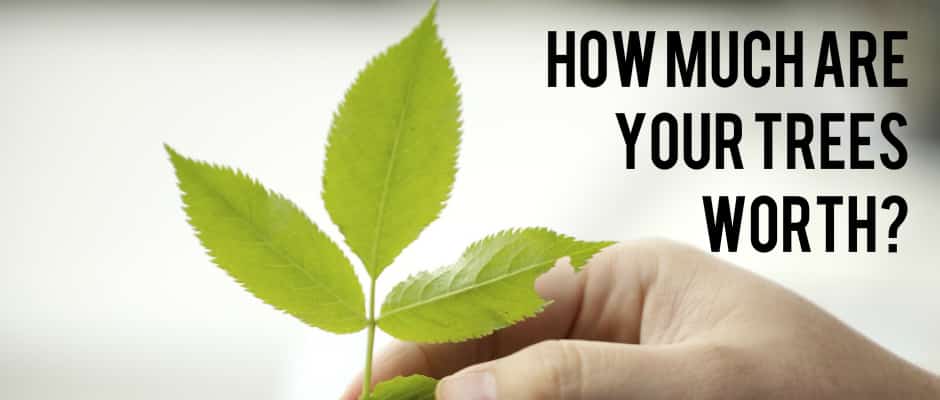[vc_row][vc_column][vc_custom_heading text=”It’s Arbor Day! Do You Know How Much Your Trees Are Worth?”][vc_single_image image=”525″ img_size=”full”][/vc_column][/vc_row][vc_row][vc_column][vc_column_text]The next time you step outside into the soothing shade of a tree, know that Mother Nature is giving you much more than shade. As a matter of fact, trees are a gift that keeps on giving.
“Whereas many home items like roofing and siding depreciate in value over time, trees contribute increasingly more value to your property as time goes on,” says R.J. Laverne, a board-certified master arborist at The Davey Tree Expert Company. “The right tree properly maintained can live 100 years or more and increases in value every year.” This seemed like an appropriate post for Arbor Day 2014!
Trees increase home values
Studies show that real estate values are impacted by the presence or absence of trees. “Data shows that buyers are willing to spend three to seven percent more on homes with ample trees versus few or no trees,” says Laverne. A 2010 study done on the value of home landscape trees in Portland found that the presence of street trees increased the sale price of homes by an average of $8,870.
Check out our article about DIY landscaping to beautify any yard, big or small.
Generally, the bigger a tree grows, the more it is worth, which is why older trees tend to be pricier. A variety of factors play into the value of your tree, including its size, health, the tree’s distance from your home and its species. Fast-growing trees like cottonwoods tend to die young, so they aren’t worth as much as slower growing species, like oaks.
A plant appraiser can determine how much an individual tree is worth, but on average it can range from a few hundred dollars for a young tree to thousands of dollars for a mature tree.
Add to the value of your trees how much they save you on energy, and you’re talking a significant amount of money. Shade from trees reduces the need for air conditioning. Studies have shown that parts of cities without cooling shade from trees can literally be “heat islands” with temperatures as much as 12 degrees F. higher than surrounding areas, says Laverne.
Check the value of your trees
You can determine the value of your trees with Davey’s Treesense Mobile App, which is powered by the USDA Forest Service iTree Design. Use the app to calculate the many benefits of your trees, including energy savings, storm water interception and how they improve air quality.
Maintenance is important
Just as properly maintaining your trees can be worth tens of thousands of dollars, not caring for your trees can be a huge financial drain. Improperly maintained trees or those planted in the wrong place experience a shortened life span. A declining tree detracts from your property value, even becoming a liability, and having a failing tree removed is also costly.
With a little investment in terms of pre-planning and maintenance, you can guarantee that your trees thrive. Keep the following tips in mind.
- Plant the right tree in the right spot. Research how large the tree you want to plant grows to make sure that it will fit in the desired planting location at maturity.
- Consider below ground health. The condition of a tree’s root system determines the tree’s overall health. Underground disturbances can profoundly affect the health of a tree, so protect the root zone by avoiding digging and running over the area with heavy equipment and vehicles.
- Mulch. Replace grass under the canopy of a tree with a 2- to 3-inch layer of mulch, which will result in the tree getting more water and beneficial nutrients and micro-ingredients. The wider the area of mulch the better, as long as it starts two to three inches from the trunk.
- Be attentive. Call an arborist if you see signs of decay, such as open cavities, hanging limbs, discolored leaves and early leaf drop. Recognizing the early stages of some tree diseases can make a difference in whether the tree will survive.
- Water. Keeping young trees well watered in the first two to three years is critical to long-term health. In the absence of rainfall, water trees on a weekly basis and more frequently during especially hot weather.
- Staking. The only time staking is necessary is if a tree is in danger of falling over in high winds. Use flat straps to attach the tree to the stakes, and remove the stakes at the tree’s one-year planting anniversary.
- Now that you know what a goldmine you have in your yard, you can give your trees a hug and thank them.
[/vc_column_text][/vc_column][/vc_row]

